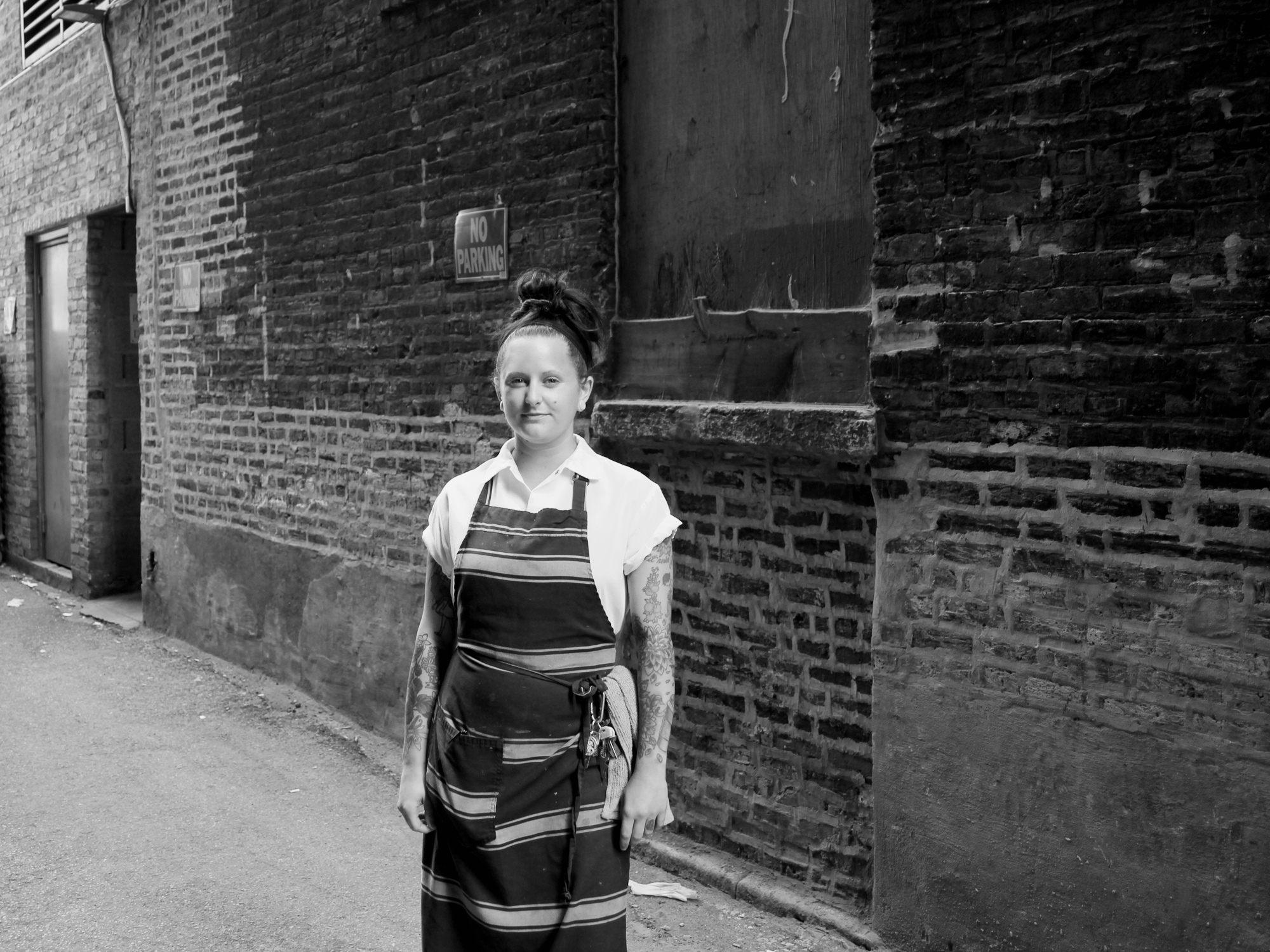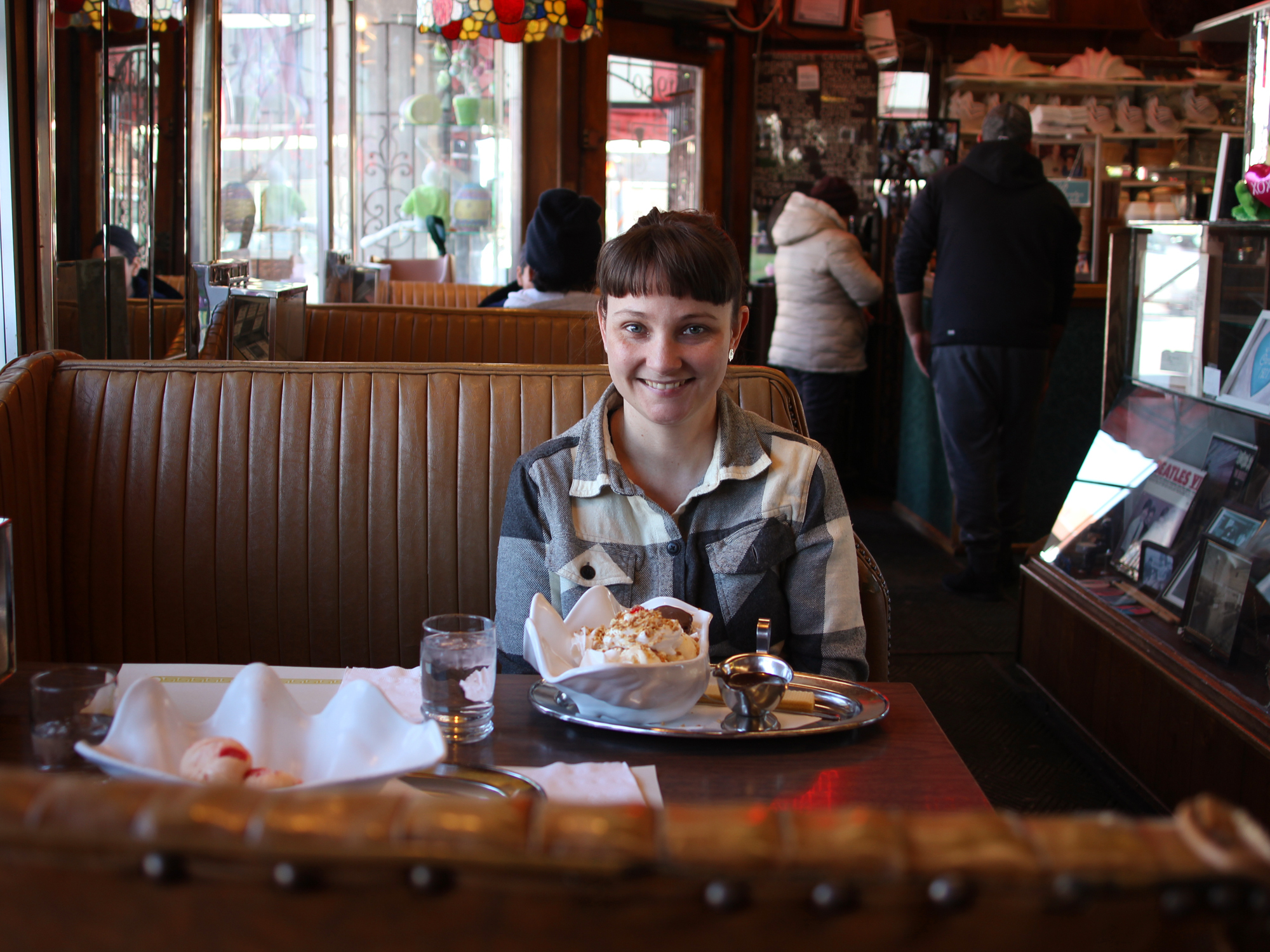THE MOST SURPRISING THING ABOUT Paul Kahan’s first cookbook, Cheers to the Publican: Repast and Present: Recipes and Ramblings from an American Beer Hall, is that—Paul Kahan has a cookbook? Twenty years after he came on the scene, in an age when chefs are routinely scooped up into celebrity, Kahan has kept his focus on his restaurants, not on his personal brand. He’ll do publicity when it’s good for the company, and he’s always been accessible to me for coverage about his actual food, but when he was approached about being a contestant on Iron Chef America a decade ago, for instance, he couldn’t volunteer Avec’s Koren Grieveson in his place fast enough.
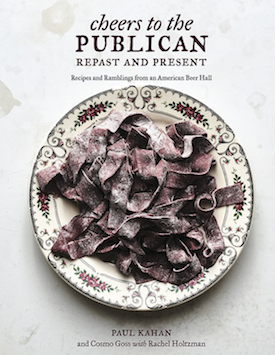
The book
Yet here it is, a handsome volume from a top cookbook publisher, Ten Speed Press, and it even has his photo on the back (which, as you’ll read, he has mixed feelings about), though as you flip through it, you’re more likely to see someone he buys pork or arugula from. It’s called Cheers to the Publican, written with Cosmo Goss (who was chef de cuisine at The Publican then, though he’s since left to launch his own project, Pacific Standard Time, with Erling Wu-Bower) and food writer Rachel Holtzman. Which means, incidentally, that it’s not about the first restaurant that made Kahan’s name, Blackbird, but rather his third, his “oysters, pork and beer” hall plus its two offshoots (the deli/sandwich shop Publican Quality Meats and the bakery Publican Quality Bread).
So why is this the restaurant that he chose to offer the public recipes (and an ethos) from, and what do he and Goss hope to accomplish by actually going out and doing publicity for it together in a few cities in the next few weeks? To answer these questions, I did the only thing that made sense: I invited them to tell me all about it over a beer at The Publican.

Cosmo Goss and Paul Kahan
FOODITOR: You’ve probably been approached about a cookbook before, I’m guessing. Why did you choose to do a Publican one, rather than a Blackbird one, or Avec or Big Star or whatever?
PAUL KAHAN: When I was a Food & Wine Best New Chef in 1999, I signed up with an agent—Nancy Silverton maybe connected me with her agent, Janis Donnaud. She’s a pitbull, she’s incredible. I tried to write a book twice. Maybe it was three times. The first time was with, believe it or not, [current New York Times critic] Pete Wells. We actually met in New York, we hashed out the idea, he was too busy, I was too busy—I really didn’t want to write a book, to be honest with you, I wanted to work in the kitchen.
The second time was with a gal named Paula Disbrowe. She worked for some publication in Illinois, Restaurant News or something, but she writes cookbooks now, she wrote Donald Link’s cookbooks with him, she runs a dude ranch in the hill country in Texas, she’s great. I tried to do this seasonal cookbook with her, we got a little bit going, and then I was like, don’t want to do it.
The third one was with Michael Ruhlman, we were going to write a comic book cookbook. It was going to be stories. We met in Cleveland, and we had a great idea, Michael was super busy and he was all over the place, we couldn’t agree on it, we couldn’t agree on an illustrator, whatever, it didn’t work.
For this one, I remember it was the time of year that we were doing employee reviews. And I think three of the chefs de cuisine said, adamantly, in their reviews that they wanted to work on a cookbook with me. Cosmo was the most persistent. I was coming back from an event in New Orleans, my agent called me and said, you know, there’s a gal named Rachel Holtzman, who lives in Brooklyn, who’s moving back to Chicago. She’s an amazing writer, I think you guys would be a great match, you should meet her, you should write a book. I had Cosmo’s words echoing in my head, “C’mon, let’s write a book, c’mon, let’s write a book.” And I said, I think it might be the time.
Really, the thing that echoes, and Cosmo can jump in at any time, is that I never wanted to do a book about myself. Like, when I was in the meeting with the artistic people from Ten Speed, and I could tell they wanted to know, do I want my picture on the cover. They don’t want your picture on the cover, and the last thing I ever wanted was my picture on the cover. I didn’t want my picture even anywhere in the book.
The Publican’s so unique in that we’ve gone from a restaurant with a unique philosophy of how we do the menu every day, to a restaurant and a butcher shop, to a restaurant, a butcher shop, and a bakery. So we thought of telling it from the standpoint of that growth, and from the standpoint of all of our vendors, what actually makes the restaurant great. We’re hardworking people and it’s an incredible team, and everyone’s passionate and it’s a lot of fun. But ultimately I think we focus so much on our vendors [in the book] because, they’ve made what we do special—
COSMO GOSS: They make us look good.
KAHAN: They’re who plants an oyster, and lives that process, and then sees it mature and reaps that harvest and gets to do that every year. Our restaurant is controlled so much by the stuff that comes in the back door on a daily basis from different places around the country. That’s what dictates the menu. And so that was kind of Cosmo’s idea for the approach to the book, and to be honest with you, of course Blackbird is super near and dear to my heart, as is Avec, but The Publican is probably the most true expression of what I think cooking should be.
I’m not going to lie, I’ve sort of been checking the reviews on Amazon. There’s only like six so far, but people have been posting pictures of what they cook, which is really kooky.
I think with a lot of careers, and you see this not just with chefs but with painters or movie directors or anybody, the first thing you do, you really go all out to show all your art and be avant-garde and show off everything you can do. And somewhere down the line, you kind of get back to basic principles, what do I like to eat, what makes me happy.
KAHAN: Very true. And I think there’s a philosophy behind procurement of product at The Publican, because of Cosmo, because of Brian Huston [The Publican’s first chef de cuisine], because at that point in my career I spent the most of my time there.
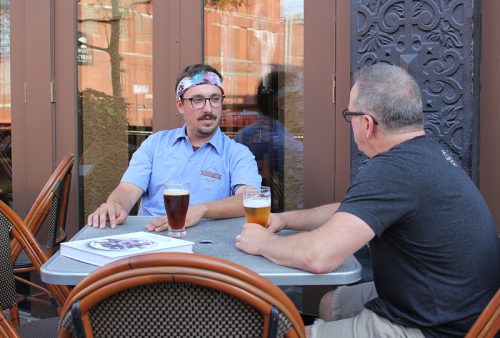
Like, in the early days at Blackbird, there were a couple of guys there—one was Brian Wolf, who lives out in California and is Charles Schwab’s private chef now, but he worked in our kitchen and then went off to work [in Los Angeles] at Lucques and a.o.c. for Suzanne Goin. He was all about the products and the markets, as was I.
And I think Cosmo is the embodiment of the guy now, being where he’s from in California and having his connections out there. We spent five days on the West Coast with these incredible producers, product that I had only seen as it came in the back door, I’d never been to the farms or the ponds it came from. Ultimately, though, I think the spirit of The Publican and the product we use embodies all of our restaurants.
So Cosmo, if you’re the product guy, is that the story that you wanted to tell when you said to Paul, “I want to be part of a book?”
GOSS: I think the original idea was like, let’s talk about plums, where we get our plums from, and so on. And that evolved into what it is now, which is, about all the people who bring us stuff. There was stuff along the way where I’d say, hey Paul, you have to try this plum. And he’d say, why would you ship plums from California, we live in the midwest. And I’d say, you’ve just got to try this plum, if you don’t like it, I won’t order them again, I won’t waste the money. And everybody’s like, “Oh my God, where are these from again, what did you say, we’ve got to get these all the time.”
KAHAN: Sometimes, also, it’s a way for us to extend our season. We get stuff for such a short time in the midwest, so maybe we get plums for a month earlier from California. I mean, we utilize local product to the utmost, but some of the things he’s brought in are incredible.
GOSS: We’re so local-sustainable-organic. I think probably my favorite farm in the midwest is Henry Brockton [Henry’s Farm], I think he’s the most amazing guy in the world, I live in Humboldt Park and I drive every Saturday to Evanston for the farmers market, I would say 95% because of him. One time I said, “Paul, you know this Henry Brockman guy?” And he just started laughing, “Of course I know him, I drove there for fucking forever—”
KAHAN: When Henry and [his sister] Terra started The Land Connection, I think we did the first benefit for their foundation at Blackbird. So yeah, we’ve known them forever.
It was funny, I was leafing through it and I knew all the farmers, these are all the famous farmers in Chicago. I was maybe a little disappointed that you weren’t naming anybody more unusual, that I didn’t already know about. And then I realized, what they’re all famous for is that they sell to Blackbird. Like LouisJohn Slagel, that’s where it began for him.
KAHAN: He went to Rob [Levitt] at, before Butcher & Larder he went to Rob at Mado. And Rob said, go see Paul. And I remember the day, standing in front of the counter at Blackbird and he had these two half-inch-thick samples of frozen steak. We had a nice conversation, and I pumped him up a little bit, I said it’s going to be a leap of faith. I said you’re probably going to have to bite the bullet for a while and your gas might cost you more than you’re selling in product. But he’s a super-determined young guy, and his product is really good.
Let’s talk about the recipes in the book—starting with the cover, which shows something which, by the way, I was there when it happened. Which was that you, Cosmo, made blood-based pasta for a Dark Lord beer dinner. Was that your clever way of getting something butcher-y onto the cover without scaring people off in bookstores?
KAHAN: I wonder if your story is different from mine about how it ended up on the cover. The blank plate?
GOSS: Paul wanted a blank plate with food that had just been finished, it was dirty, the silverware was kind of laid to the side—
KAHAN: It’s a beautiful photo, we loved it.
GOSS: We loved it, but they were just like…. mmmm, no. And Paul was like, c’mon, c’mon, please, let’s try it. They sent it to every person who could possibly have influence on the book, and every person was like mmmm, no. It’s got to be food.
KAHAN: Actually, my agent said, if that’s what you want, you need to have them run it by the people who are going to sell the book. And they did, and those people were like, no.
And then, at a certain point, the layouts for the book were coming back from Ten Speed and they weren’t exactly what we wanted. Cosmo and I went through the photos and meticulously picked out what we thought were the best.
GOSS: It was hours.
KAHAN: They took so many photos. But I got on a plane and went to San Francisco. My publisher, Lorena Jones, she picked me up and we were driving to Tartine Manufactury to get some breakfast. And she asked, “What’s going on with the cover?” She said, “We have some ideas.” Those weren’t so great, and I just texted Peden + Munk, the photographers, and within about an hour we had ten options. We were in the car heading over to Ten Speed, and I showed that one to Lorena, and she was like, “I like that one.”
The thing about it is, you don’t look at it and go, “blood pasta.” It’s not going to turn you off from buying the book—you might say beet pasta. You don’t exactly know what it is.
[He grabs the book and opens to the inside back cover, a photo of half-drunk glasses with the word “CHEERS” scrawled in red.]
Did you see that? That’s blood, too, beef blood that Cosmo was using to make the pasta. So we were excited about that.
Well, it fits the ethos of the restaurant, which is kind of nitty-gritty about butchering meat, but at the same time, refining it and making it attractive to the diner.
KAHAN: And they were totally game about the book being in our voice that way. We would just go into a room with Rachel and just babble. And she did an incredible job translating it. She was like a wrangler, a writer, a translator—
GOSS: An MVP—
KAHAN: All those things. And there were times—Lorena, our editor, would say we can’t use this word because it’s trademarked.
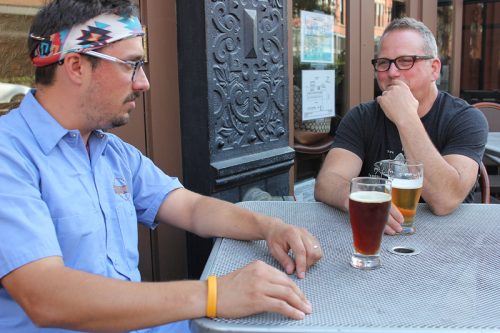
GOSS: What couldn’t we use?
KAHAN: We couldn’t use “saltine.” We just said “the best.” But there was one where we needed a way to say more flavor, and I said “more action,” and she said “I like that.” So that’s our voice. There’s a pork belly recipe in there with a big “X” through it—
I was going to ask about that. You’re the guy who made pork belly what it is today!
KAHAN: Yeah, expensive. I don’t take credit for doing pork belly because when we were doing it at Blackbird, Tom Colicchio was doing it at Gramercy Tavern, and I think Thomas Keller was doing pork belly as well. I’d lie if I said I wasn’t inspired by what Tom Colicchio was doing. But certainly I don’t think anyone was doing it in Chicago, and we did it with a vengeance, and loved it.
It’s just kind of become… everyone does it now.
GOSS: You can’t take it off the menu [at The Publican], because so many people come for it.
KAHAN: The “X” is a little tongue in cheek. Like our Anti-Tweezer Manifesto. Tweezers are good for some things, we’re just trying to make a little bit bigger of a statement here.
But Blackbird is a little more tweezer-y than it has been, at the moment.
KAHAN: It is. Ryan [Pfeiffer, Blackbird chef-de-cuisine] sent me multiple texts of the book and all the guys in the kitchen with their tweezers, he sent me videos of plating stuff with tweezers, over and over again. He understands, it’s a little bit broader of a philosophical statement.
So pork belly was one iconic Publican dish, and another is the barbecued carrots—
[Kahan chuckles skeptically. Writers!]
I think it represented an evolution from a pork-centric restaurant—
KAHAN: Meatdom, yeah. We talk about that a lot in the book. When Brian Huston was the chef, I’d tell him, dude, we need more vegetable dishes, we need more offerings in that column. I don’t think there was even a vegetable column when we opened, there was the Little Gem Salad—
GOSS: And French fries.
You say in the book that if anyone wanted a vegetable plate, it was basically dealer’s choice, all the cooks had to come up with something on the fly.
KAHAN: Yeah, and then Cosmo came and it all changed.
GOSS: I’m a veg-head, I grew up in Southern California. I joke that I have quinoa and avocado in my veins.
KAHAN: No way!
[Ed. note: PQM has a quinoa and avocado sandwich called the No Way.]

GOSS: There was a guy here named Jethro Felton, he’s now at NOPA in San Francisco, and he was like, I’m going to try grilled carrots for a dish. And I said, you’re out of your goddamned mind. And then we tried them and I’m like, there’s something to it but it needs something. And we’re all thinking, barbecue and ranch dressing is so good, but Paul will kill me if I put ranch dressing on the menu. So we made “creamy herb dressing,” and we got these really amazing pecans from this pecan farm, and now we’ve pigeonholed those three things because they haven’t come off the menu in four years.
KAHAN: But the real inspiration was Chris Lilly—
GOSS: The barbecue rub comes from Chris Lilly, who wrote the cookbook from Big Bob Gibson’s in Alabama. His Memphis dry rub, we use a variation from that. And he came in to eat one day, and I thought, oh my God, he’s going to eat these carrots, he’s going to be like, “Hey, this tastes familiar.” So I’m freaking out, and I call Paul and say, “I’m just going to say ‘Chris Lilly Carrots’ on the menu, is that okay with you?”
KAHAN: I think the rub in the blanching water, and then more of it after you grill them, is sort of the secret. And I’m not going to lie, I’ve sort of been checking the reviews on Amazon, there’s only like six so far, but people have been posting pictures of what they cook, which is really kooky—but everyone loves the carrots.
But everyone loves them here, too. Cosmo cooked during the Alex’s Lemonade BBQ for a massive table of like every chef who matters to me, and everyone was freaking out about the carrots.
GOSS: They got, like, raw fish from Japan for crudo, and this amazing pork, and all this seafood—and everybody was like, “Those carrots, man.”
Well, and I don’t think there’s a contradiction in going from being known for pork to being known for carrots. It’s all about bringing in great stuff and making it sing. There’s a quote in the book—I could just hear it in Paul’s voice, followed by “dumbass”—”The key ingredient in a bowl of mussels is good mussels.”
KAHAN: I think “Duh.” “Duh” would be apropos.
You know, for me it’s all about the chefs de cuisine at this point, and having great food and doing something that’s interesting that we all believe in. And a lot of it is driven by what Cosmo has been doing for the last few years here. I openly admit it. It’s not about me. Can we do a picture of me and Cosmo on the back cover? No. I think we got around that for the most part. But, we have ten places now, I’m not the chef anywhere.
Okay, so talking about staff, there’s one person you talk about in the book, that I want you to tell me about in particular. Melba Ortiz. What’s the importance of Melba Ortiz?
GOSS: She’s the most important person at The Publican. If I died tomorrow, The Publican would be fine, if Melba died, we’d have to close and figure out how life would go on. She’s the longest tenured employee, she was there on day one as our opening prep cook, now she’s our a.m. sous chef. She does all of what Paul calls our mother sauces—aioli, I think crackers are a mother sauce at The Publican. She does all of our fish butchery, she runs the morning crew.
KAHAN: A typical thing with her is, you show her something and then the next day, it’s better than how you showed her. She continually refines everything and makes it better, without having to ask. The pork pies that we talk about a lot in the book are a good example. It was basically a recipe that Brian and I came up with, and we showed her, and then she basically started to show us.
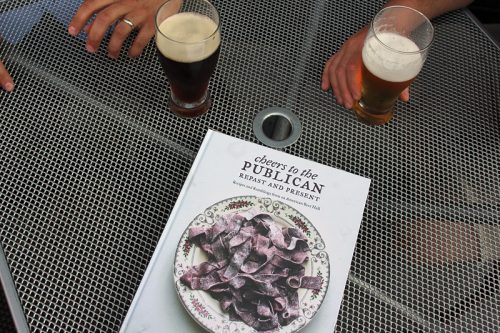
GOSS: She invented this way of cleaning sardines, and I asked her why she did it that way, and she said, I didn’t like my hands touching the guts. And it’s the best way to clean sardines ever.
KAHAN: She’s super-dedicated, and her personality is not like, Hey, I want to put a dish on the menu. Or I want credit for what I do, although I think she’s incredibly proud of being so heavily involved in the book. But she just wants to come in, and do her work super-super well. I mean, have you ever had to go to her and tell her she did something wrong?
GOSS: Never.
Have she ever told you you did something wrong?
GOSS: She’s been like, “Hey, Cosmoooo…”
KAHAN: “Hey, Cosmoooo…”
GOSS: “Did you want to do it like this?” Whatever you think is right, Melba.
I thought it was striking that you devoted a page to her, because that’s who you never see in a cookbook—the Mexican prep cooks and line cooks who all restaurants are run on the backs of.
KAHAN: At Avec we have a gentleman named Jorge, who’s been there for 12, 13, 14 years? And he carries the whole burden of the walk-in cooler on his back. He preps so much, and he’ll help when he’s done. Without sounding like it’s a sweeping generalization, I think the Latino work ethic is very strong, at least in these people. They a pleasure to work with, and they take so much pride in their work, wonderful families, they’re a huge part of our organization.
She deserves more than a page. There’s a couple of candid photos in there, where there’s like five people on the back stoop and your eyes go right to her, because she’s the boss. Even though you’re in the photo, Cosmo.
GOSS: No, she’s the boss.
Michael Gebert was the pork belly but is now the barbecued carrot of Fooditor.
Latest
Join the Discussion
After you comment, click Post. If you're not already logged in you will be asked to log in or register with Disqus.





